By Bryan Ling (17S06C)
Raffles Press Vice Chairperson
After every exam or common test, a common lament of humanities and science teachers alike is for students to improve on their general neatness and handwriting. But despite the insistence and pleas of our tutors, it seems like far too few of us actually heed their requests for us to improve our handwriting.
Right before the March holidays, a few Raffles Press and Raffles Publications writers of varying handwriting standards embarked on the adventurous task of changing up their handwriting. Some, like me, were just there to try and become legible. Others already had passable handwriting, and were looking to switch up their style. But, under the guidance of self-taught aesthetic master Jeanne Tan, in the short span of a week we all managed to take significant steps towards changing our handwriting style.
7 Students and their Thoughts before the Exercise
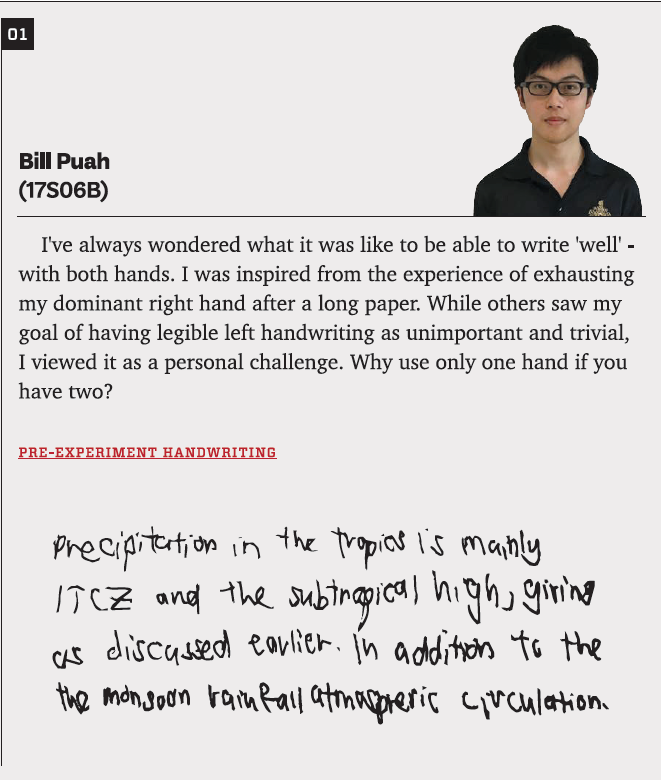
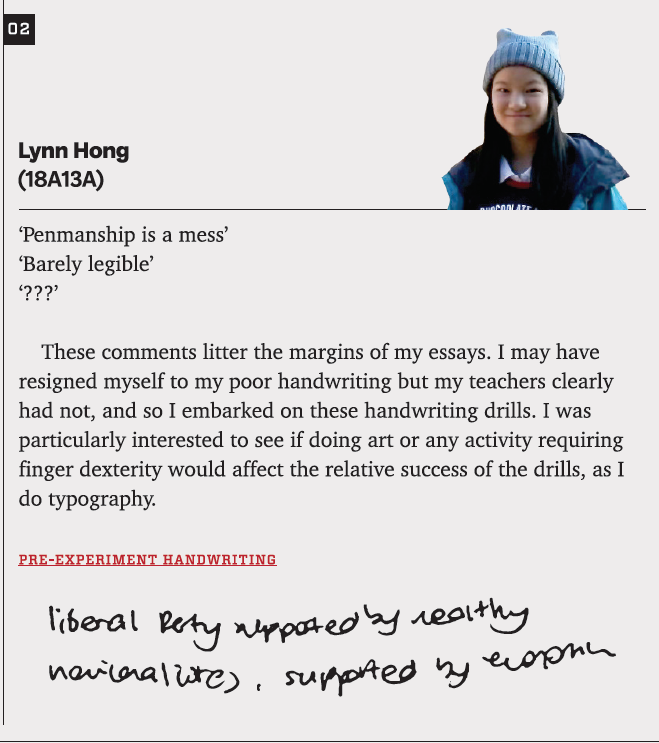
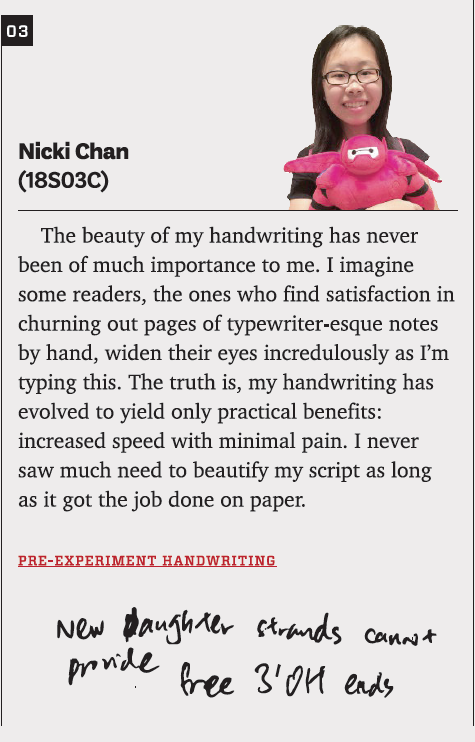
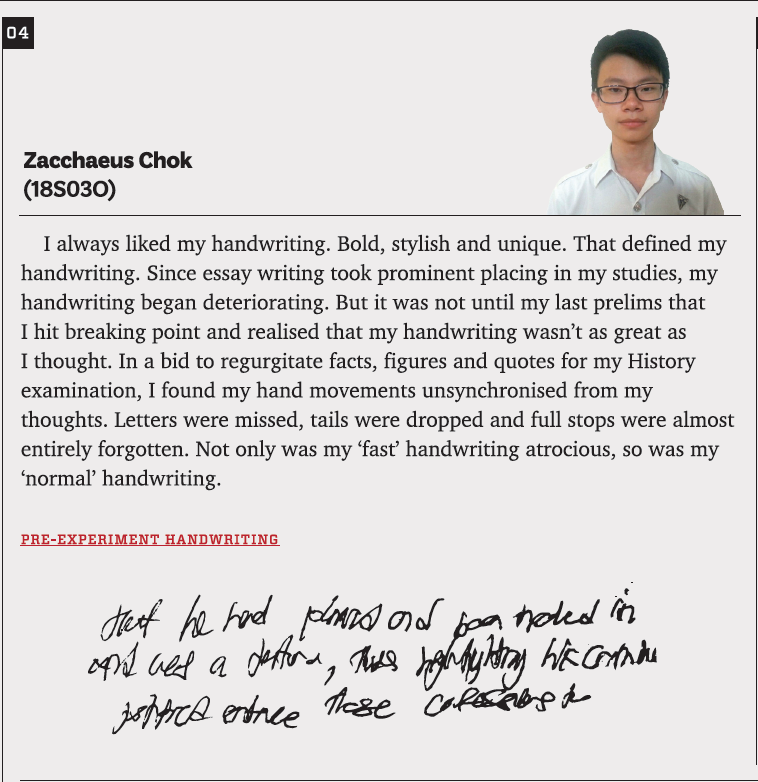
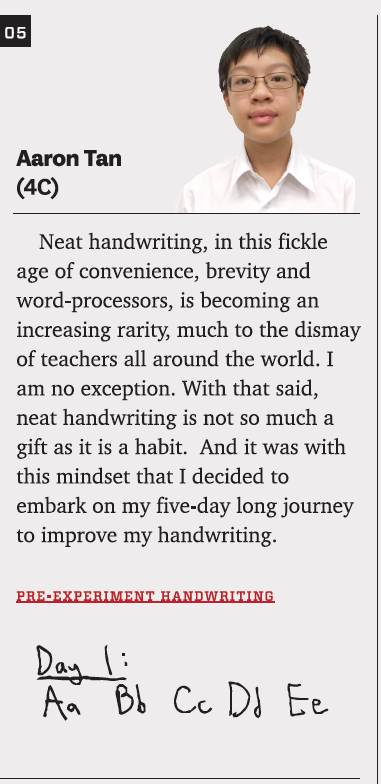
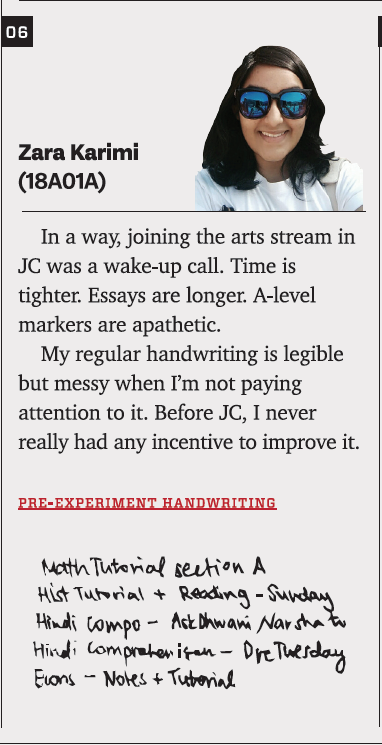
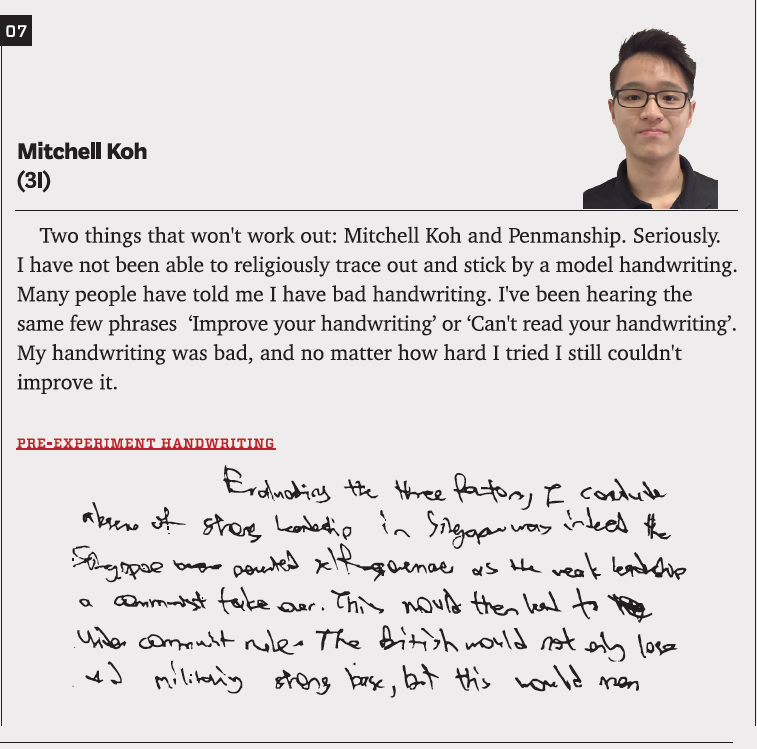
Part one of the exercise acquainted our writers with their desired handwriting,
based off the shrimp method by user prrb on Tumblr. It follows six simple
steps to practise and memorise the characteristics of the handwriting. Each
writer chose a handwriting sample from the internet, which formed the basis
of the style and the goal for their challenge.
Step 1: Write something in your normal handwriting (‘I love studying at Raffles Institution!’)
Step 2: Trace over the letters of the sample of desired handwriting.
Step 3: Copy the letters on a separate sheet of paper with reference to the sample.
Step 4: Copy out any short text with reference to the sample.
Step 5: Copy out the text without reference to the handwriting sample.
Step 6: Rewrite the original sentence.
The Goal: simulate real-life studying scenarios: Writing under time pressure, or taking lecture notes.
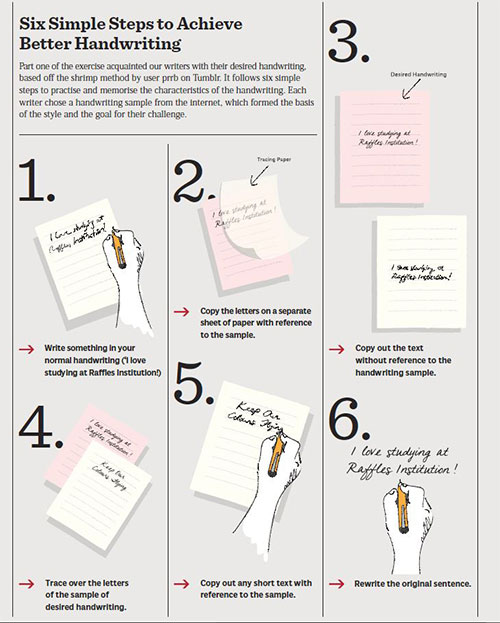
Thoughts During The Experiment
I selected a simple, blocky style, and made time the primary focus of my handwriting efforts. Tracing letters was manageable, save the occasional hand cramp, but the real challenge would be taking notes in this style. – Zara Karimi
The replication of the template handwriting was easier than expected – with concentrated force of will I could produce a more convincing duplicate than other challengers. But any semblance of advantage fell apart under time pressure. The erratic loops of my ‘A’s and the sideway scrawls of my ‘G’s crawled back into my script in the rush to commit thought to paper. So artists, I regret to conclude that you stand little advantage here. – Lynn Hong
Before I began, I questioned whether such effort to change my handwriting was necessary as a large portion of writing had migrated to technology. It would not be uninformed to suggest that my handwriting would not matter much soon given the pace of technological advancement. The immense strain the exercise had on my arm was a surprise. At one point, I felt my palm ache from the overly tight grip of my fingers round the pen. Ironically, as I got into the flow of the exercise, I felt addicted and refused to let go of the pen. – Zacchaeus Cheok
As I couldn’t find a suitable handwriting sample to emulate on the web, I did what any younger brother would do and turned to my older sister for her handwriting sample. Two weeks later, my ‘A’s don’t look like ‘E’ and my capital ‘D’ finally doesn’t look like a semi-circle. – Mitchell Koh
The first task was tracing another’s handwriting from a chosen template and it felt good to look at the tracings and pretend my handwriting had always been flawless. Sadly, this was not the case once I started copying out typed text in a poor imitation of the template handwriting. My hand throbbed, certain muscles overworked by unusual contortions and my writing speed was reduced by at least half. The third part of the challenge, transcribing a spoken paragraph, was further torture for me, as my frantic scribbling hopelessly lagged behind the ongoing narration. – Nicki Chan
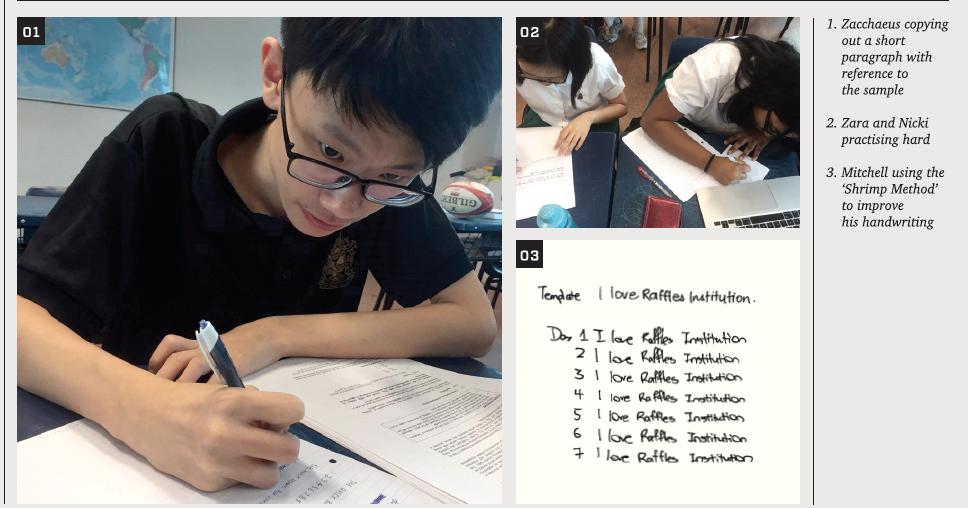
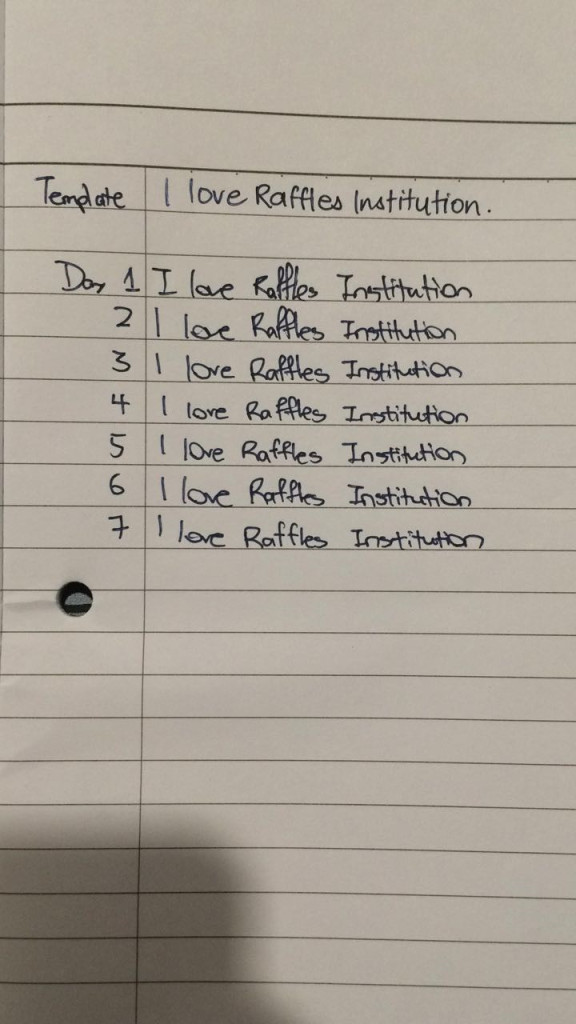
Final Thoughts
Expectedly, the concentrated focus on my handwriting had a destructive influence on my ability to think coherently and form links between different spheres of knowledge. Given the steep 'handwriting' learning curve and the taxing strains on my hand, I would say it's not worth to train handwriting to be aesthetically pleasing for others. —
Bill Puah
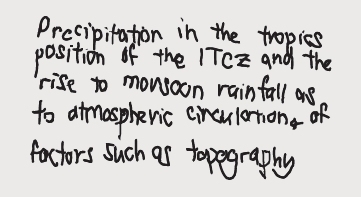
My handwriting returned to its primordial chaos not long after I stopped practicing. For lasting impact, the drills would have to be sustained over much longer periods of time.
That said, the drills did temporarily correct some tics in my handwriting - but at what cost? The process was excruciatingly boring, and I was frustratingly aware of how much faster I could have worked. The easy rejoinder, of course, is the A levels card – your brilliant essay means nothing if your examiner can’t read it. There’s also the allegation levelled at those with poor handwriting, that we don’t take enough pride in our work and it somewhat rings true. I spend hours labouring over letterforms in typography and yet, I cannot muster the patience to execute this most basic of tasks well.
Handwriting, as much I hate to admit, is key to clear and effective communication, so I leave this article in search of greater diligence and neater letters. —
Lynn Hong

tl;dr of the exercise, it was tiring. Period.
In slowing down to perfect my handwriting, I would slow down my thought process, resulting in me losing my train of thought. Tasks that should have only taken me fifteen minutes ended up needing forty-five, and I felt like I could better spend my time instead of focusing on the uniformity of my handwriting. By the end of the week, the amount of effort I had put in did not justify the output. Aside from neatness, there was very little impact on the overall quality of my work. If I really wanted to write in my new style, it would require a lot more concentrated effort. I know that I don’t want to commit to that, seeing as I have very little time and energy to spare as it is. —
Zara Karimi

The results speak for themselves – I saw a marked improvement in my handwriting without having to significantly slow my pace. It all goes to show that the quality of one’s handwriting is really all about one’s state of mind. With enough practice, I am confident one will be able to train oneself to consistently attain higher standards of handwriting. —
Aaron Tan
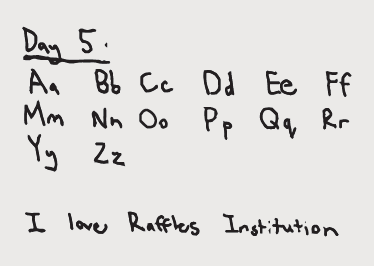
Like most, I had personal qualms about changing my handwriting. My handwriting grew with me and was something personal to me. I believe that our handwriting is a mirror of one’s personality. Would a deliberate attempt to improve on my handwriting have an effect on my personality? Would my new handwriting be considered artificial? Such questions, albeit trivial, did pose a concern.
Judging by my final samples, perhaps the aphorism ‘A leopard cannot change his spots’ does have its merit. Just as my handwriting will always possess some form of resemblance to my original one, my personality will remain rooted.
As someone who judges decisions based on the outcome and expectedly, I do not think that it was worth it. For the strong-willed and those determined to change their handwriting no matter what, I guess motivation would lead to more desirable results. —
Zacchaeus Cheok

After much thought on the matter, I managed to convince myself that handwriting should be a big deal. Everyone cares about their handwriting to varying degrees, and most of us tweak our handwriting, sometimes fairly unconsciously, to suit different occasions. I cannot imagine crafting a loved one’s birthday message in the handwriting I use on examination scripts.
More than that, however, it can very well be argued that there are more links between handwriting and our personality than you would think. Someone who knows you well enough can identify your work in a stack of 30 assignments. Whether it’s artful cursive, neat Calibri-like script or the trademark indecipherable handwriting many well-educated professionals seem to have – one’s handwriting allows glimpses into the writer’s personality.
All things considered, penmanship is as good as a part of our identity. To be able to write in a way that pleases others as well as oneself can do wonders for one’s morale. Practically speaking, as students, we do most of our work by hand and it would be a good idea to draw the line at illegible penmanship should we want our efforts to be taken seriously. For these reasons, I wanted to put my determination to the test despite my initial apathy towards the idea, and challenge myself to revamp my handwriting.
Surprisingly, I did not fare as badly as some of my peers in this challenge. Although my handwriting still looks nothing like the template’s, I continue to work on it. The subtle improvements I see every time I put pen to paper are enough to keep me going. That and the strange satisfaction gained from writing in even strokes and orderly alignment.
I guess it’s my turn to stare incredulously at my past self. —
Nicki Chan
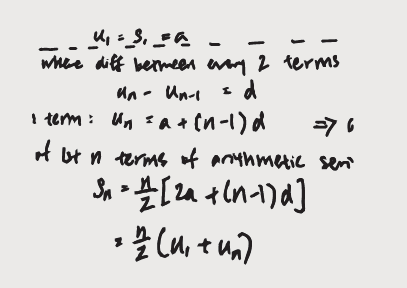
The daily routine of ending my day with 5-minutes of focused handwriting practise, certainly rubbed off on me. Comparing my neater, more reader-friendly handwriting to my old, messy, visually jarring, I feel so accomplished!
I now believe that I am capable of neat handwriting, at least until the essay practices come along. Perhaps the clearest indication of improvement came from my friends reaction as I showed my friends them my samples and they refused to believe they were mine. This handwriting challenge has provided me the opportunity to change something that I always thought was too difficult. Wonder if it's now time for some Art challenge...—
Mitchell Koh
